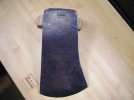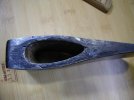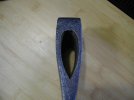


Picked it up off ebay last week. After looking carefully at it I still can't find any remnants of a stamp anywhere besides the one that just says "Sweden." I've seen both old Hults and old Gransfors that were painted blue like this one but they all had stamps on them. I can't tell if it's hand forged either. There are a some marks towards the front of the poll that look like an old drop forged axe or a new Gransfors but the eye looks a little too clean, and there's no crease (that I can see) at the front of the eye where it would have been folded. Any ideas?
Thanks





